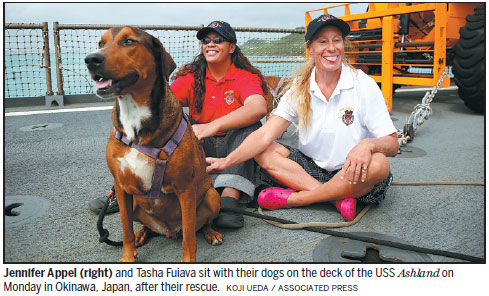Inconsistencies cast doubt on survival tale
HONOLULU - Two women who said they were lost at sea never activated their emergency beacon, the US Coast Guard said, adding to a growing list of inconsistencies that cast doubt on their harrowing tale of survival.
The women previously said that they had radios, satellite phones, GPS and other emergency gear, but they didn't mention the Emergency Position Indicating Radio Beacon.
A Coast Guard review of the incident and subsequent interviews with the survivors revealed that they had an EPIRB aboard the Sea Nymph, but never turned it on.
Jennifer Appel said in an interview on Tuesday that in her experience the beacon should only be used when you are in imminent physical danger and going to die in the next 24 hours.
"Our hull was solid, we were floating, we had food, we had water, and we had limited maneuverable capacity," she said in an interview in Japan, where the US Navy took them.
"All those things did not say we are going to die. All that said it's going to take us a whole lot longer to get where we're going."
Previously, Appel and Tasha Fuiava had said they were close to giving up when the US Navy rescued them last week, thousands of kilometers off course.
The EPIRB communicates with satellites and sends locations to authorities. It's activated when submerged in water or turned on manually. The alert signal sends a location within minutes.
A retired Coast Guard officer who was responsible for search and rescue operations said that if the women used the emergency beacon they would have been found.
"If the thing was operational and it was turned on, a signal should have been received very, very quickly that this vessel was in distress," Phillip R. Johnson said.
Johnson described the device as sturdy and reliable, but added that old and weak batteries could cause a unit not to function.
Appel and Fuiava also said they had six forms of communication that all failed to work.
"There's something wrong there," Johnson said. "I've never heard of all that stuff going out at the same time."
The two women, who are from Hawaii in the United States, met in late 2016, and within a week of knowing each other decided to take the trip together. Fuiava had never sailed a day in her life.
They planned to take 18 days to get to Tahiti, then travel the South Pacific and return to Hawaii in October.
They set off on May 3 and were rescued by the US Navy last week, thousands of kilometers off course.
Key elements of the women's account are contradicted by authorities, and are not consistent with weather reports or basic geography of the Pacific Ocean. The discrepancies raised questions about whether Appel and Fuiava could have avoided disaster.
On their first day at sea, May 3, the two women described running into a fearsome storm that tossed their vessel with 100 kilometer per hour winds and 9-meter seas for three days, but meteorologists said there was no severe weather anywhere along their route during that time.
The National Weather Service in Honolulu also said no organized storm systems were in or near Hawaii on May 3 or in the days afterward. Archived NASA satellite images confirm there were no tropical storms around Hawaii that day.
Associated Press

(China Daily 11/01/2017 page11)














